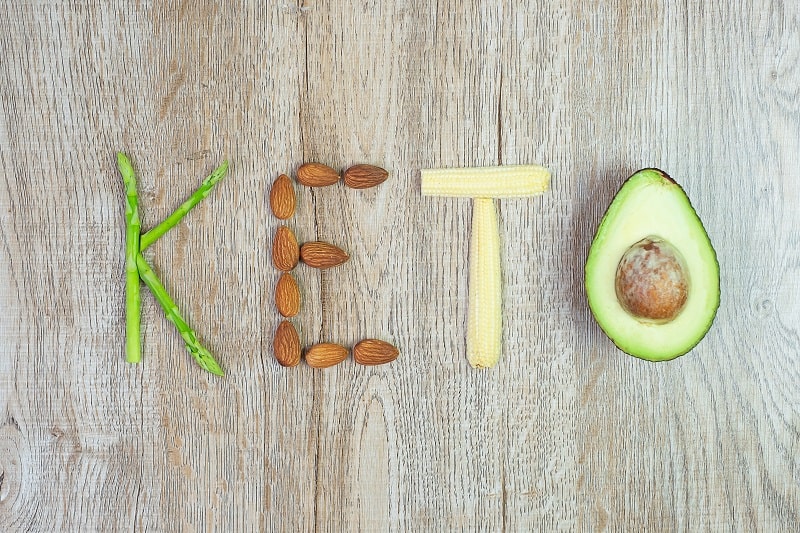What is the Keto Diet?
The Keto Diet, short for the ketogenic diet, is a low-carb, high-fat diet that has gained popularity in recent years. It involves reducing carbohydrate intake and replacing it with fat, which puts the body into a metabolic state called ketosis.
In ketosis, the body becomes more efficient at burning fat for energy, leading to weight loss. The diet has also been associated with various health benefits, including improved blood sugar control, reduced inflammation, and increased mental clarity.
However, it is important to note that the Keto Diet may not be suitable for everyone, and it is always recommended to consult with a healthcare professional before starting any new diet or making significant changes to your eating habits.
How Does the Keto Diet Work?
The ketogenic diet, commonly known as the keto diet, is a low-carb, high-fat diet that has gained popularity in recent years. It works by forcing the body into a state of ketosis, where it primarily burns fat for fuel instead of carbohydrates.
This is achieved by drastically reducing the intake of carbohydrates and increasing the consumption of fats. When the body is in ketosis, it produces ketones, which are molecules that are used as an alternative source of energy.
This metabolic state has been shown to have various health benefits, including weight loss, improved mental clarity, and increased energy levels.
Benefits of the Keto Diet
The Keto Diet offers numerous benefits for those who follow it. One of the main advantages is weight loss. By restricting carbohydrates and increasing fat intake, the body enters a state of ketosis, where it burns fat for fuel instead of glucose.
This leads to rapid and sustained weight loss. Additionally, the Keto Diet has been shown to improve blood sugar control and insulin sensitivity, making it beneficial for individuals with diabetes or pre-diabetes.
Other benefits include reduced inflammation, increased energy levels, and improved mental clarity. Overall, the Keto Diet can be an effective and sustainable way to improve health and achieve weight loss goals.
Getting Started with the Keto Diet
Understanding Macronutrients
The macronutrients are the three main components of our diet that provide us with energy: carbohydrates, proteins, and fats. Understanding macronutrients is essential for following a keto diet effectively.
In a keto diet, the primary focus is on consuming a high amount of healthy fats, a moderate amount of protein, and a low amount of carbohydrates. This macronutrient ratio helps the body enter a state of ketosis, where it burns fat for fuel instead of carbohydrates.
By understanding macronutrients and their role in the keto diet, individuals can make informed choices about their food intake and optimize their weight loss and overall health goals.
Calculating Your Macros
When it comes to following the keto diet, calculating your macros is an essential step. Macros, short for macronutrients, refer to the three main nutrients that make up our diet: carbohydrates, fats, and proteins.
By determining the right balance of these macros, you can ensure that your body enters a state of ketosis, where it burns fat for fuel instead of carbohydrates. To calculate your macros, you need to consider factors such as your weight, activity level, and goals.
There are various online calculators and formulas available to help you determine the ideal macro ratios for your keto diet. It’s important to note that these ratios may vary depending on individual needs and preferences.
Once you have calculated your macros, you can use them as a guide to plan your meals and track your food intake to stay on track with your keto journey.
Creating a Keto Meal Plan
Creating a Keto Meal Plan is an essential step in following the ketogenic diet. A well-designed meal plan can help individuals maintain ketosis, reach their weight loss goals, and ensure they are getting the necessary nutrients.
When creating a keto meal plan, it is important to focus on high-fat, low-carb foods such as meat, fish, eggs, dairy, and healthy fats like avocado and olive oil. It is also important to limit the intake of carbohydrates, including grains, starchy vegetables, and sugary foods.
By carefully planning meals and snacks, individuals can ensure they are providing their bodies with the right balance of nutrients while staying in ketosis.
Foods to Eat on the Keto Diet
Healthy Fats
The Keto diet emphasizes the consumption of healthy fats. These fats are an essential part of the diet as they provide energy and support various bodily functions. Some examples of healthy fats include avocados, nuts, seeds, and olive oil.
These fats are rich in monounsaturated and polyunsaturated fats, which are beneficial for heart health and can help reduce inflammation in the body.
Incorporating these healthy fats into your Keto diet can help you feel satiated and maintain a healthy weight.
Low-Carb Vegetables
The keto diet emphasizes consuming low-carb vegetables, which are rich in nutrients and low in carbohydrates. These vegetables include leafy greens like spinach and kale, cruciferous vegetables like broccoli and cauliflower, and other low-carb options like zucchini and bell peppers.
Incorporating these vegetables into your meals can provide essential vitamins, minerals, and fiber while keeping your carbohydrate intake in check.
Additionally, these vegetables add variety and color to your plate, making your meals more visually appealing and enjoyable.
Protein Sources
Protein is an essential macronutrient that plays a crucial role in the keto diet. It helps in building and repairing tissues, supporting immune function, and producing enzymes and hormones.
When following the keto diet, it is important to choose protein sources that are low in carbohydrates. Some excellent protein sources for the keto diet include meat, poultry, fish, eggs, and dairy products.
These sources not only provide high-quality protein but also contain essential nutrients like vitamins and minerals. Incorporating a variety of protein sources into your keto diet can ensure that you meet your daily protein needs while staying in ketosis.
Foods to Avoid on the Keto Diet
High-Carb Foods
High-carb foods are those that are rich in carbohydrates, which are the body’s main source of energy. These foods typically include grains, such as rice, pasta, and bread, as well as starchy vegetables like potatoes and corn.
Other high-carb foods include sugary snacks and drinks, such as cookies, cakes, and soda. While these foods can provide quick energy, they can also lead to weight gain and blood sugar spikes.
For individuals following the keto diet, it is important to limit or avoid high-carb foods in order to maintain a state of ketosis, where the body burns fat for fuel instead of carbohydrates.
Processed Foods
Processed foods are a common staple in many people’s diets. These foods undergo various procedures to extend their shelf life and enhance their taste.
However, they often contain high levels of added sugars, unhealthy fats, and artificial additives. Consuming too many processed foods has been linked to an increased risk of obesity, heart disease, and other chronic health conditions.
It is important to limit the intake of processed foods and focus on whole, unprocessed foods for a healthier diet.
Sugary Drinks
Sugary drinks are a major concern when it comes to following the keto diet. These beverages are typically high in added sugars and can quickly derail your efforts to maintain a state of ketosis. Consuming sugary drinks can lead to spikes in blood sugar levels, which can inhibit the body’s ability to burn fat for fuel.
It is important to avoid sugary drinks such as soda, fruit juices, and energy drinks, as they can not only hinder weight loss but also increase the risk of developing various health conditions, including obesity, type 2 diabetes, and heart disease.
Instead, opt for water, unsweetened tea, or other low-carb beverages to stay hydrated and support your keto journey.
Managing Side Effects of the Keto Diet
Keto Flu
The Keto Flu is a common side effect that some people experience when starting the keto diet. It is a collection of symptoms that can occur during the transition from a high-carb diet to a low-carb, high-fat diet.
These symptoms can include fatigue, headache, irritability, nausea, and dizziness. The Keto Flu is caused by the body adjusting to the new fuel source and can last anywhere from a few days to a couple of weeks.
It is important to stay hydrated, get enough electrolytes, and eat enough fat during this time to help alleviate the symptoms.
Electrolyte Imbalance
An electrolyte imbalance can occur when the levels of electrolytes in your body are too high or too low. Electrolytes are minerals that are essential for the proper functioning of your body, including maintaining a healthy balance of fluids, transmitting nerve signals, and contracting muscles.
The keto diet, which is low in carbohydrates and high in fat, can sometimes lead to an electrolyte imbalance, particularly in the initial stages of the diet. This is because the diet restricts the intake of certain foods that are rich in electrolytes, such as fruits and starchy vegetables.
It is important to be aware of the signs of an electrolyte imbalance, such as muscle cramps, fatigue, and irregular heartbeats, and to take steps to maintain a proper balance of electrolytes while following the keto diet.
Digestive Issues
The Keto diet can sometimes cause digestive issues. This is because the diet is high in fat and low in carbohydrates, which can lead to changes in the gut microbiome and digestive processes.
Some common digestive issues that people may experience on the Keto diet include constipation, diarrhea, and stomach discomfort.
It is important to stay hydrated and include plenty of fiber-rich foods in the diet to help alleviate these digestive issues. Additionally, gradually transitioning into the Keto diet and allowing the body to adapt can also help minimize digestive problems.
Conclusion
Is the Keto Diet Right for You?
The Keto Diet is a low-carb, high-fat diet that has gained popularity in recent years. It is known for its ability to help people lose weight and improve their overall health. However, it is important to consider whether the Keto Diet is right for you before starting.
This diet requires a significant reduction in carbohydrate intake and an increase in fat consumption, which may not be suitable for everyone.
It is recommended to consult with a healthcare professional or a registered dietitian to determine if the Keto Diet is a good fit for your individual needs and goals.
Tips for Long-Term Success
When it comes to long-term success on the keto diet, there are a few key tips to keep in mind. First, it’s important to be consistent with your meal planning and preparation. This will help ensure that you have keto-friendly options readily available and reduce the temptation to stray from your diet.
Second, make sure to stay hydrated by drinking plenty of water throughout the day. This will not only support your overall health but also help prevent the common keto flu symptoms. Lastly, don’t forget to listen to your body.
Pay attention to how you feel and adjust your diet and macros accordingly. Remember, the keto diet is not a one-size-fits-all approach, so it’s important to personalize it to meet your own needs and goals.
Consulting with a Healthcare Professional
Before starting any new diet or making significant changes to your current eating habits, it is important to consult with a healthcare professional. This is especially true for a diet like the Keto Diet, which involves a significant reduction in carbohydrates and an increase in fat intake.
A healthcare professional can assess your individual health needs and provide personalized guidance and recommendations to ensure that the Keto Diet is safe and appropriate for you. They can also monitor your progress and make any necessary adjustments to your diet plan.
Consulting with a healthcare professional is crucial to ensure that you are making informed decisions about your health and well-being.







